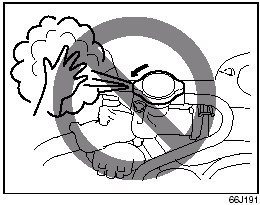If the Engine Overheats
The engine could overheat temporarily under severe driving conditions. If the engine coolant temperature gauge indicates overheating during driving: 1) Turn off the air conditioner, if equipped.
2) Take the vehicle to a safe place and park.
3) Let the engine run at normal idle speed for a few minutes until the indicator is within the normal, acceptable temperature range shown by the white band between “H” and “C”.
 WARNING:
WARNING:
If you see or hear escaping steam,
stop the vehicle in a safe place and
immediately turn off the engine to let
it cool. Do not open the hood when
steam is present. When the steam
can no longer be seen or heard, open
the hood to see if the coolant is still
boiling. If it is, you must wait until it
stops boiling before you proceed.
Also, be careful not to touch hot engine parts (radiator, water hoses, engine etc.).
If the temperature indication does not
come down to within the normal, acceptable
range:
1) Turn off the engine and check that the
water pump belt and pulleys are not
damaged or slipping. If any abnormality
is found, correct it.
2) Check the coolant level in the reservoir.
If it is found to be lower than the “LOW” line, look for leaks at the radiator, water pump and radiator and heater hoses. If you locate any leaks that may have caused the overheating, do not run the engine until these problems have been corrected.
3) If you do not find a leak, carefully add coolant to the reservoir and then the radiator, if necessary. (Refer to “Engine Coolant” in the “INSPECTION AND MAINTENANCE” section.)

 WARNING:
WARNING:
• It is hazardous to remove the radiator
cap when the water temperature
is high, because scalding fluid and
steam may be blown out under
pressure. The cap should only be
taken off when the coolant temperature
has lowered.
• To prevent personal injury, keep hands, tools and clothing away from the engine cooling fan and airconditioner fan (if equipped). These electric fans can automatically turn on without warning.
See also:
Interior
Suzuki has taken advantage of its expertise in the compact car segment to
efficiently execute larger — yet still tidy — proportions that afford comfort
and practicality without the wasted spac ...
On-Road
In everyday driving, the Equator rides and handles the way a midsize pickup
should. It's smoother than a full-size and easier to park, but without V-8
power. All the test units were 4x4s; we hoppe ...
New for 2010
There are no significant changes for 2010. ...
